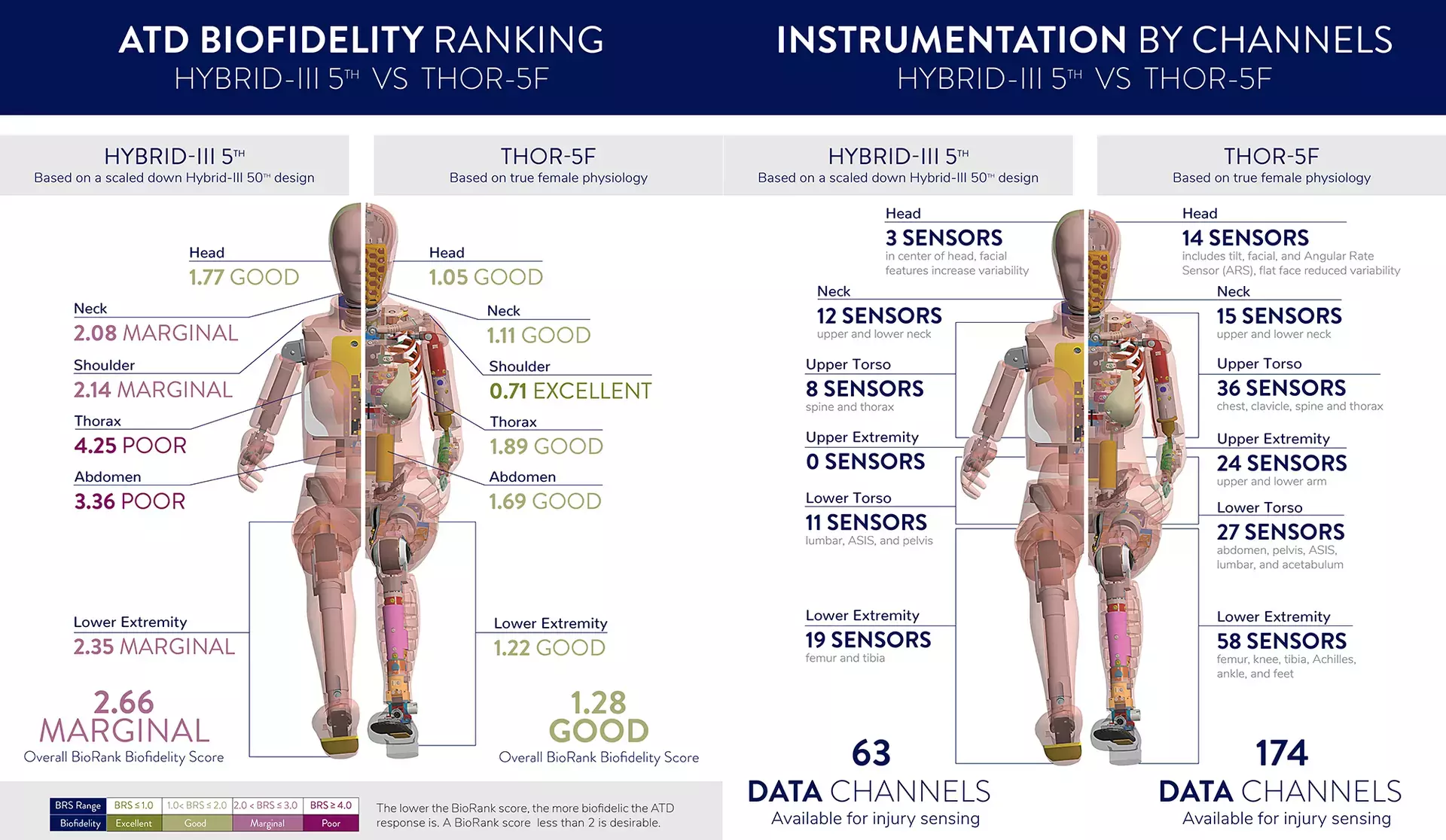
Exploring the Differences Between the THOR-5F female and the Hybrid III 5th Crash Test Dummies
Crash test dummies have been an integral part of vehicle safety research and development for decades, allowing engineers to test the effectiveness of new vehicle designs and technologies in physical crash tests as well as computer simulations of crash tests. But not all crash test dummies are created equal. For example, the Hybrid III 5th currently used in some safety test protocols and the newer advanced THOR-5F (Test device for Human Occupant Restraint) are both designed to simulate the physical characteristics of a small-stature female. However, there are some significant differences and implications between the two dummies pertaining to the accuracy of representing the female physiology and fidelity of data produced from crash test results.
There is ongoing debate about the need for more crash test dummies that truly represent the female physiology. Some experts argue that because men and women have different physical characteristics such as height, weight, bone density, and muscle mass, using only male-based crash test dummies may not accurately predict the safety risks for female occupants in a crash. There is evidence to support this notion that gender can influence injury risk during a crash. Studies from NHTSA have shown that although risks to women have improved with newer vehicles compared to a similar study from 2013, they are still more likely than men to be injured in car crashes, which remains to be unacceptable today. 1
Some experts argue that because men and women have different physical characteristics such as height, weight, bone density, and muscle mass, using only male-based crash test dummies may not accurately predict the safety risks for female occupants in a crash.

The THOR-5F was developed by the National Highway Traffic Safety Administration (NHTSA) to address the need for a more advanced and realistic female crash test dummy. Unlike the previous Hybrid III dummy design, the THOR-5F is meant to be more extensive with a greater stable of instrumentation representing a larger range of body regions, effectively providing new data and insights on injury. With her design based on true female anatomy and a more accurate representation of the human skeleton, she has a more detailed and anatomically correct female pelvis and spine and a more realistic head and neck. The THOR-5F exists to address concerns about the increased risk to females in real world crashes and the current underrepresentation of women in crash test protocols ,
The Hybrid III 5th, on the other hand, is a modified version of the Hybrid III 50th male, which has been in use since the 1970s. The Hybrid III is based on the "50th-percentile male" body shape, which represents the average male in terms of size and proportions. The 5th dummy was developed in the 1990s and has been used in automotive testing to evaluate the safety of vehicles for female occupants. This dummy, however, has been criticized for being less advanced than the THOR-5F. Critics argue that the Hybrid III 5th’s limited measurement capabilities and simplified skeletal system can result in limitations in the assessments of vehicle safety for female occupants, effectively not giving engineers enough data to design the optimum safety in vehicles .
However, with the THOR-5F’s more advanced sensors and measurement capabilities, engineers have the ability to collect more information about injury risk experienced by the dummy during a crash test. She has room for up to 174 channels of injury sensors while the Hybrid-III 5th typically only has about 63 channels. At the most fundamental level, it’s hard to understand what you don’t measure. That’s why such expansive new data can and should be used to better understand the physics of the crash, advance vehicle safety designs and to develop new safety technologies.
At the most fundamental level, it’s hard to understand what you don’t measure.
For example, the THOR’s more human-like pelvis shape and measurement capabilities in this area can pinpoint a particularly harsh injury type caused by the seat belt riding over the pelvic bone. In addition, the THOR-5F can measure the loads to an occupant’s acetabulum in an attempt to reduce the risk of acetabulum fractures in the real world. Lastly, with the increased risk of females suffering lower extremity injuries, the three-fold number of data channels in the legs of the THOR-5F make pinpointing these injuries much more meaningful.
In combination with more available data points, the THOR-5F’s anatomical accuracy has earned it a biofidelity ranking that has been explicitly shown to be a step up from the Hybrid-III, ensuring a more accurate human-like response during testing and improving the quality of the information she collects.2

The auto industry has increased the library of crash test scenarios in which vehicles are tested over the last few decades. This has allowed vehicles to be designed for a wider range of accident types observed in the field. Unfortunately, the newer crash test protocols so far have not included the latest crash dummy technologies which are currently available. The industry must do both; advance crash test configurations as well as including the latest dummies that have advanced biofidelity and measurement capability.
It's not hard to see that the THOR-5F is a more advanced and detailed test dummy compared to the Hybrid III 5th and is designed to better simulate the specific risks to women in a crash. The use of true female crash test dummies allows vehicle manufacturers and safety agencies to evaluate the safety of vehicles for both men and women, providing a more complete picture of vehicle safety and increasing the level of protection for all passengers. The THOR-5F's advanced measurement capabilities and intricate design make it an invaluable tool for advancing vehicle safety.

Next: Let’s take a look at representation for Every Body in occupant protection
1 Source: Female Crash Fatality Risk Relative to Males for Similar Physical Impacts, NHTSA August 2022 2 NHTSA Research Portfolio Research Meeting, Nov 2022 *Wang et al. 2018 IRCOBI

Mark Brown
Mark is the Product Marketing Manager at Humanetics Safety and works closely with Engineering and Sales to develop and refine content that is both useful and informative for our industry. With over two decades of experience in crash test dummy product Quality, Technical, Sales, and Marketing, Mark produces a wide range of media and publications including our service bulletins, webinars, editorial articles, and contributes to our marketing collateral.